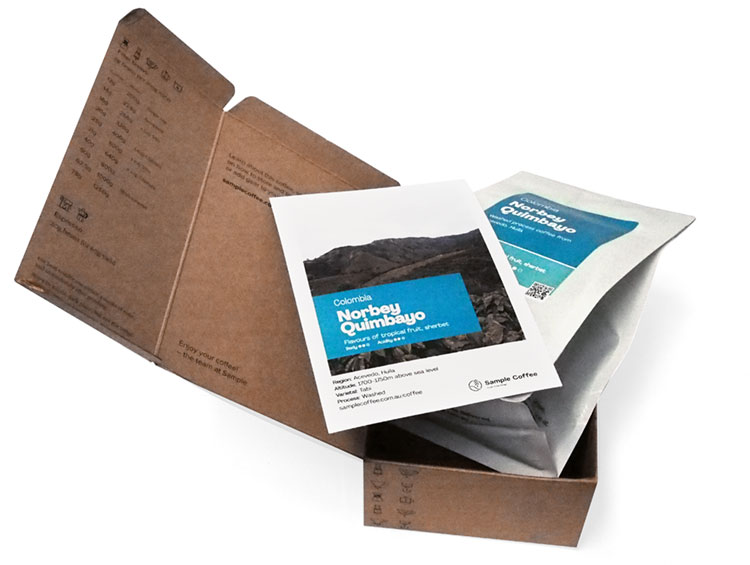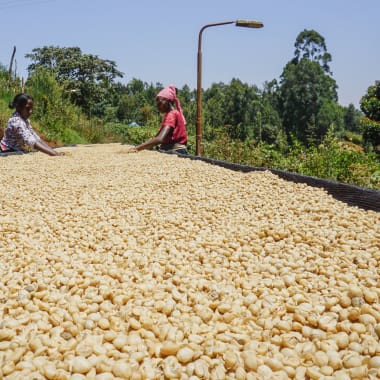-
Producer
-
Amilcar Perez
-
Country
- Guatemala
-
Region
-
Canalaj, Huehuetenango
-
Altitude
-
1750-1800m above sea level
-
Varieties
-
Process
-
Harvested
-
February 2020
-
Importer
-
Cafe Imports
-
Body
-
Medium
-
Acidity
-
Balanced
-
Tasting notes
-
Red cherry, cola, brown sugar
-
Roast style
Guatemala
Finca La Bendición
Amilcar PerezAmilcar Perez owns a 1.2 hectare farm where he has just about 500 coffee trees planted. After picking the ripe coffee, it’s depulped that same day, the coffee is fermented for 18–28 hours, on average, before being washed twice or three times and laid out to dry on patios or nylon for 3–4 days.
This week we’re sharing our subscription coffee from Guatemala for the year, with this crop from Amilcar Perez’s farm Finca La Benedición.
It’s a 1.2 hectare farm in Canalaj, within the Huehuetenango region that might be familiar. where he has just about 500 coffee trees planted.
After the ripe coffee is picked, it’s depulped that same day, then fermented for 18–28 hours. Once fermented, it’s washed two or three times and laid out to dry on patios or nylon for 3–4 days.
Guatemala’s production of coffee first grew in the 1860s on the back of a declining indigo trade, which had previously existed as its main export. Until 2011 Guatemala was in the top 5 highest producing coffees nations in the world, before being overtaken by Honduras.
The region of Huehuetenango is a non-volcanic area characterised by high altitude and a predictable climate. It’s often considered to produce the highest quality coffee in the country – characterised as the most fruit-forward and can be the most complex of what Guatemala has to offer.
The geography that helps produce the region’s flavours also creates challenges: most farmers are required to process their own coffee, rather than attempting the difficult journey to transport the cherry to a mill for processing.
Learn everything about this coffee:
Ethical, traceable sourcing
This page has all the sourcing information (variety, process, region, story, importer, and more) that our importers share with us, and give us permission to use.
The transparency helps us talk confidently about the quality and background of our product, and it helps you know exactly what you’re buying.
Learn more:
Coffee page transparency legend
Our coffee philosophy
Our business approach
Fresh harvest coffee
We only source and roast coffee from each country’s latest harvest season (so the green coffee is never older than 1 year from the time of picking, processing and packing). This ensures the sensory qualities are always at their peak and unaffected by excessive ageing.
Roasted for espresso and filter (best enjoyed black)
Roast style: omni. Omni roasts are designed to brew and taste great both as espresso and filter. Our omni single origins generally sit on Agtron values in the ~70-60 value range. So, technically, they are somewhere in the lighter side of the medium spectrum.
Designed for espresso and filter brewing. Best enjoyed black.
Learn more:
Our Loring Kestrel S35 roaster
Our roasting style and approach
Best brewed within days 15-49 post-roast
The ‘fresh is best’ saying doesn’t apply to coffee (contrary to popular belief). Waiting before opening and brewing your bag of whole coffee beans helps develop peak flavour and acidity.
But heads up: if you buy pre-ground coffee, brew it as soon as possible.
Learn more:
Our recommended brewing window
Try our custom brewing recipes
Our recipes and ratios are tailored to our coffee sourcing and roasting styles, bringing the best flavour and feel out of each coffee.
For pour over, immersion, and other filter brewing styles, check our brew guides.
For our espresso single origins, we recommend a coffee:yield ratio of 1:3:
- Dose: 20g ground coffee
- Yield: 60g espresso
- Total brew time: ~24-28 seconds
This is just a starting point! We encourage you to experiment, taste, and adjust to find the recipe that you enjoy the most.
Learn more:
Our espresso brew guide (single origin)
Brewing ratio calculator
Packaging and sustainability
- Bags: ABA-certified home compostable (AS 5810-2010)
- Labels: recyclable
- Valves (only on +250g bags): general waste
- Box and tape (online orders): recyclable
Learn more:
Our packaging
Varieties
Bourbon variety
A natural mutation of the Typica varietal, Bourbon is named after Reunion Island (then known as Il Bourbon) where the French cultivated the Typica plants which naturally mutated.
Caturra variety
Caturra is a natural mutation of Bourbon that was originally discovered in Brazil in 1937, considered to be the first naturally occurring mutation ever discovered.
Pacamara variety
A cross-breed between Pacas and Maragogype, developed in El Salvador in 1958
The location
Coffee from Guatemala
Guatemala’s production of coffee first grew in the 1860s on the back of a declining indigo trade, which had previously existed as it’s main export. Up until 2011 Guatemala was in the top 5 highest producing coffees nations in the world, before being overtaken by Honduras.
The Huehuetenango region of Guatemala
A non-volcanic region of Guatemala characterised by high altitude and predictable climate. Often considered to produce the highest quality coffee in Guatemala
Farm processes
Washed process
Machines are used to remove the flesh from the coffee cherry before being fermented in water, washed again, and finally sun dried. This process tends to result in more distinct, cleaner flavours.

Subscribe to a world of coffee
Discover a new single origin coffee from Sample every 1-5 weeks with no delivery fees.
No up-front purchase, and you can pause, cancel, or change plans at any time.
Available to order online this week:

Ethiopia Girma Sintayehu Honey
Flavours of apricot, mango, coconut, pineapple
Body Acidity
Honey 75227, Wolisho
February 2025 harvest
Roasted omni for filter and espresso
Ethiopia Girma Sintayehu Honey online
Ethiopia Bekele Gemeda
Flavours of mandarin, white peach, mango
Body Acidity
Washed Ethiopian Heirloom
November 2024 harvest
Roasted omni for filter and espresso
Ethiopia Bekele Gemeda online
Kenya Karindundu Aa
Flavours of orange marmalade, grapefruit, Yunnan red tea
Body Acidity
Washed Batian, SL28, SL34, Ruiru 11
Roasted omni for filter and espresso
Kenya Karindundu Aa online
Nicaragua Guillermo Montenegro
Flavours of plum, nectarine, shortbread
Body Acidity
Washed Caturra
March 2025 harvest
Roasted omni for filter and espresso
Nicaragua Guillermo Montenegro online